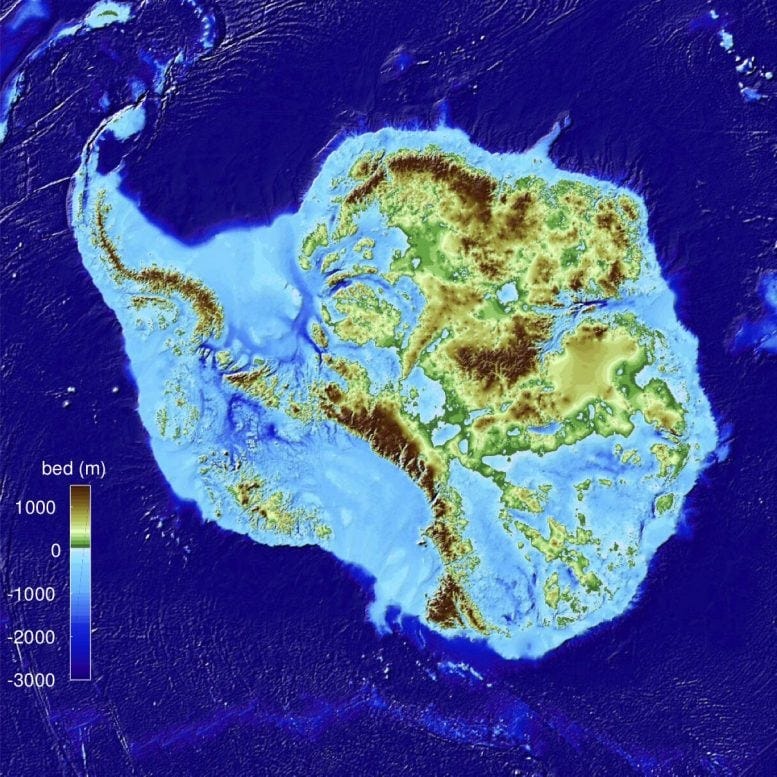The Weird Science Drop #16 ⏰ If you could turn back time
Where to live to extend your life, say goodbye to toilet paper, drugged-up cavemen, plus the secrets of Antarctica unlocked.
Bbde mo!* We’ve always been told that there’s no going back. If you’ve ever made a mistake, there’s no way you can travel back in time to fix it. However, while this holds true in everyday life, when you get down to the quantum realm, time itself gets a little more flexible. More on this, plus where potatoes came from, blaming your sore head on Neandertals, and why Bluey is good for kids. So hit that subscribe button!
Daniel
* Hello in Tibetan
Joke: What do you call someone who investigates molten rocks?
(answer at the foot of email)
Weird Science News
⏲ Physicists say they have figured out a way to turn back time. While I’m obviously disappointed this method doesn’t feature a DeLorean, Marvel fans will no doubt be pleased that it does feature the quantum realm - yep, the same one featured in Ant-Man and Avengers: Endgame.
It turns out you can speed up, slow down, and even reverse the flow of time at the quantum level, like a DJ spinning the decks. Suffice to say, there’s a lot of maths involved and it’s all rather complicated (with stuff about ‘evolving photons’ and crystals), but I love how one researcher involved in the study, Miguel Navascués, explains it:
“In a theater (classical physics), a movie is projected from beginning to end, regardless of what the audience wants. But at home (the quantum world), we have a remote control to manipulate the movie. We can rewind to a previous scene or skip several scenes ahead.”
Popular Mechanics has the full story
🌊 If you want to live longer, get yourself a home overlooking the ocean. Researchers from Ohio State University looked at census records for 66,263 people and found that living near the coast was associated with keeping the Grim Reaper at arm’s length.
What has left them scratching their heads, though, is that people who live near lakes or rivers inland do not get the same benefit. There are probably many factors behind the apparent discrepancy. Researchers point to coastal areas having fewer hot days and fewer cold days, better air quality, and more chances for recreation.
The result rather backs up the idea that the bracing sea breeze is good for you. Back in Victorian times, people were just as obsessed with clean air as we are today, probably because of all the new factories pumping out smoke and grime. All the rage at the time was the 'seaside cure' that saw ailing patients being taken to the seaside to cure them of all ills so they could then return home, safe and well. Read more on Science Alert
🚽 Toilet paper’s days are finally numbered. First made commercially available in the pre-packaged form we know and love in 1857, it’s probably time we moved on. But to what?
Of course, the answer should be the three seashells. However, the real-world solution to the environmental problem toilet paper poses is… the washlet toilet.
These hi-tech washlet toilets use adjustable water jets for pressure and temperature, offering a personalised clean. Some models even include air dryers for a fully hands-free, paper-free experience. Read more on IDR
🧠 Scientists have shone a laser through the human head in what’s being seen as a big jump in medical tech. Normally, when docs want a close look at the inside of your noggin they either use an EEG or an MRI - but both have their limitations.
An EEG is cheap and portable, but not much use beyond the outer layers of the brain, while the MRI doesn’t have that problem but is massive and very expensive.
A team from Glasgow have spent years coming up with something that marries the best of both worlds by working out a way of shining a light through the head to get a good picture of what’s going on inside. Read more on IEEE Spectrum
😣 Talking of heads, if you’re unlucky enough to suffer from regular headaches you now have someone to blame - the Neanderthals. It appears that when our ancestors interbred with our close cousins all those years ago, we inherited genes that affect pain sensitivity, inflammation and skull shape, all of which can increase the risk of chronic headaches and migraines.
A recent study looked at the DNA of thousands of people and found that those who had certain Neanderthal-derived genetic variants were more likely to suffer from headaches.
Alas, for the moment, this clue hasn’t led to a cure. I must point out, though, not everything we got from Neanderthals is negative - a stronger immune system and denser bones to name but two. Read more on Times of India
The weird origin story of the potato
Ever since Sir Walter Raleigh brought them back from the New World to impress his girlfriend Queen Elizabeth (as is my understanding), we’ve been very partial to a potato - be that baked, roasted or chopped up for fries. But it’s never occurred to me to question where they really came from.
Even though it’s one of the world’s most popular crops, it’s been a mystery that, errr, vegetable probers have been chasing the answer to for a long time. But the riddle has now been solved, and the answer even rhymes!
The spuds we know and love actually evolved from the tomato some nine million years ago. According to new research, natural ‘interbreeding’ in the wild between tomato plants and a potato-like species from South America gave rise to the modern-day taters.
It is believed that an ancient evolutionary event triggered the formation of the tuber, the enlarged underground structure that stores nutrients found in plants such as potatoes and yams.
Professor Sanwen Huang, from the Chinese Academy of Agricultural Sciences, said:
“Our findings show how a hybridisation event between species can spark the evolution of new traits, allowing even more species to emerge. We’ve finally solved the mystery of where potatoes came from.”
Modern potato plants are almost identical in appearance to three potato-like species from Chile called Etuberosum - but these don't carry tubers.
The team's findings, published in the journal Cell, found that every potato species contained a stable, balanced mix of genetic material from both Etuberosum and tomato plants, suggesting that potatoes originated from an ancient hybridisation between the two.
While Etuberosum and tomatoes are distinct species, the researchers explained they share a common ancestor about 14 million years ago.
Even after diverging for around five million years, they were able to interbreed and gave rise to the earliest potato plants with tubers around nine million years ago.
The researchers say the tubers also allow potato plants to reproduce without seeds or pollination. They grow new plants by simply sprouting from buds on the tuber. Prof Huang added:
“Evolving a tuber gave potatoes a huge advantage in harsh environments, fuelling an explosion of new species and contributing to the rich diversity of potatoes we see and rely on today."
What’s under Antarctica?
Researchers stationed at the South Pole are forever looking down at their feet, wondering what the huge ice sheets that cover the continent could be hiding.
One puzzle they are trying to unlock is the ‘strange radio pulses’ first detected emanating from beneath the white stuff some ten years ago. But there’s plenty hidden under all that ice…
Hundreds of subglacial lakes and a huge network of flowing rivers that could harbour unique life forms that will either cure us or kill us
Lake Vostok, the biggest body of water, is thought to have been cut off from the outside world for up to 25 million years in an environment not too dissimilar to what you’d find on Jupiter's moon Europa or Saturn's moon Enceladus
The Gamburtsev Mountain Range, around the size of the Alps, is buried under a kilometre of ice. We still don’t know how they came to be
Remnants of ancient rainforests and lots of marine fossils hint at a much warmer past and even sparked speculation about what - or who - could have once called the South Pole their home
Photo of the Week
Six volcanoes in far eastern Russia are erupting following the big earthquake and aftershocks that shook the region last week. Klyuchevskaya erupted first, followed by eruptions of nearby volcanoes Shiveluch, Bezymianny, Karymsky, Avachinsky and Krasheninnikov.
For your eye holes
Blast from the past
It’s 75 years since the first ever launch of a rocket from Cape Canaveral - here, the Bumper V-2 takes to the heavens. Since this milestone, the NASA facility has sent thousands of rockets destined for Earth orbit, the Moon, planets, and even beyond.
Cool Quote
“The best way to get a good idea is to have a lot of ideas."
Linus Pauling
Weird Science Factoid
If you walked for 12 hours a day, it would take the average person 690 days to walk around the world. Is it strange that this actually sounds doable?
Fries on the Side (aka the best of the rest)
👶 You might not remember anything about when you were a baby, but that doesn’t mean your brain wasn’t making memories. A new theory has it that these infant memories are stored away in your noggin, but you’ve lost the ability to access them.
🦷 Scientists have been giving 4,000-year-old teeth a good, hard look and have found something rather interesting about our ancient ancestors. The dental plaque has confirmed that people at the time loved to chew down on a psychoactive substance. Far out, man.
🗺️ The remains of a legendary Norwegian town have been discovered after archaeologists followed the instructions left in an ancient text. They used the 'Chronicles of Hamar' to pinpoint the likely location of the medieval village before finishing the job off with state-of-the-art georadar tech.
⚔️ Napoleon famously came a cropper when trying to invade Russia, losing 300,000 soldiers to disease, starvation and the extreme cold when trying to get the hell out of there. DNA from a handful of those troops now indicates they fell victim to several diseases, including paratyphoid fever and louse-borne relapsing fever.
🐾 Kids' show Bluey - up there with The Wire as being one of the best TV shows ever created - could have more benefits than simply keeping small people entertained and out of your hair for a while. Researchers say the adventures of the famous blue heeler's family could have lifelong mental health benefits. So parents don’t have to feel guilty anymore!
More from TWSD
Monkey business
AI emperor’s new clothes
Rocket science and the occult
Most-visited links from last week’s TWSD
Ozzy Osbourne wasn’t just a music god - his legendary DNA helped science evolve
Scientists find gruesome evidence that proves ancient humans ate children 850,000 years ago
AI Models Can Send "Subliminal" Messages to Each Other That Make Them More Evil
About TWSD
Science is weird, and here’s the proof. The Weird Science Drop goes where other, more-sensible newsletters fear to tread. Every week, we grab our trusty white lab coat, bunch of bubbling test tubes and world-ending robot prototype to go in search for the overlooked, under-the-radar and, above all else, most madcap science news, views and research.
About me
Daniel Smith is an ancient experienced journalist who has worked for a host of news publishers on both sides of the Atlantic. A long, long time ago, he fancied himself as an astrophysicist but instead turned out to be the worst scientist since the man who mapped out all those canals on Mars that turned out to be scratches on his telescope's lens. Luckily, he is now not working on the Large Hadron Collider inadvertently creating a black hole that would swallow the world by pressing the big red button but is safely behind a desk writing this newsletter, bringing you the fantastical underbelly of nature... The Weird Science Drop.
Have I missed anything?
Feel free to throw me an email or just fill out this super simple form. I'll read each and every one. Promise.
Joke answer: Magma, PI!






